USS ASTORIA CA-34
The Official Home of 'Nasty Asty'
Iron Bottom Sound
The Battle of Savo Island: 9 August 1942
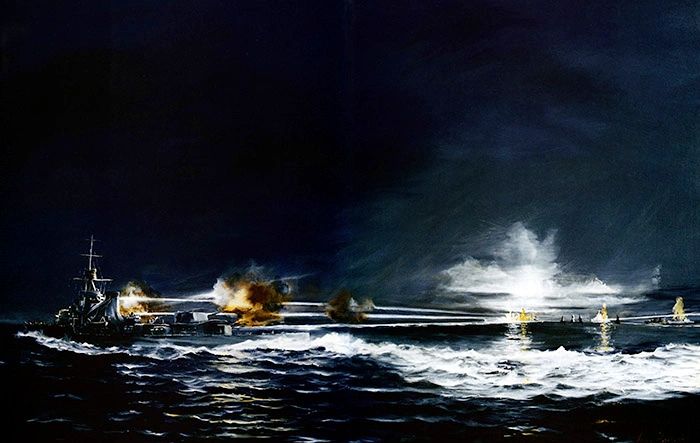
CLICK IMAGE TO ENLARGE
An iconic painting of the Battle of Savo Island. IJN YUBARI opens fire on the American cruisers ASTORIA, QUINCY and VINCENNES, each of which are bathed in Japanese searchlights.
-John Hamilton painting in the U.S. Navy Art Collection
Note: The following account is not intended to be a definitive account of the 1st Battle of Savo Island. This is primarily due to space and time constraints, as there are many accounts of this battle readily available online and in print. In the future I plan to expand upon what is documented here; for now the primary focus surrounds USS ASTORIA. The after-action reports of ASTORIA's CAPT Greenman are used to provide the progression of the battle.
At 1000 local time on 11 August 1942, the Commanding Officer of USS ASTORIA, CAPT. William G. Greenman, lay wounded aboard transport USS PRESIDENT JACKSON. Less than forty-eight hours had passed since his ship had succumbed to wounds and slipped beneath the surface in Savo Sound.
Greenman sent the following dispatch:
110200 (Mailgram) URGENT
Following preliminary report from Captain Greenman USN on cruiser action early morning of 9 August off Florida Island.
VINCENNES, QUINCY and ASTORIA while on patrol in channel eastward of Savo Island about 0155 LOVE [local time] August 9th were attacked by an enemy force of unknown number presumably four CA [heavy cruisers] and unknown number of DD [destroyers].
At time of attack our cruisers were in column; order of ships: VINCENNES, QUINCY and ASTORIA, on course 315, speed 10 with two DDs as A/S [anti-submarine] screen. First indication of enemy action was indicated by four aircraft flares seen about 5000 yards bearing 135 to 155 true from this vessel.
Enemy apparently came in under the shadow of Savo Island and made their initial attack from our port quarter bearing about 190-195 true and on easterly courses concentrating on ships from the van. Shortly after flares were dropped and seen searchlights to right of flares appeared and the enemy opened fire.

A 1942 artist's depiction of the opening moments of the Battle of Savo Island. At lower left, American transports continue to unload supplies at Guadalcanal. At center right is Savo Island, where Imperial Japanese Navy ships enter the Sound. A Japanese floatplane begins to drop flares overhead.
-Alexander Leydenfrost drawing reprinted from LIFE magazine
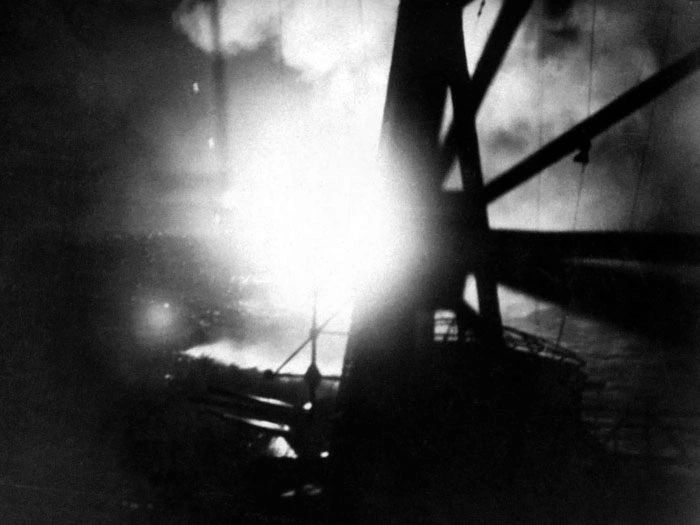
In a photograph taken from IJN CHOKAI, flares drop over the southern cruiser group of USS CHICAGO CA-29 and HMAS CANBERRA.
-Imperial Japanese Navy photo in Brent Jones collection
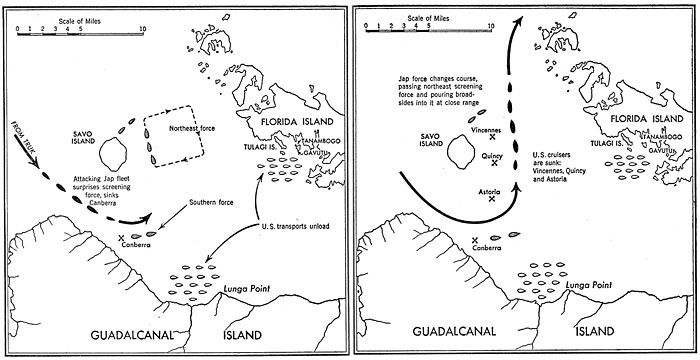
CLICK IMAGE TO ENLARGE
A 1944 drawing of the progression of the battle correctly depicts the path of the attacking Japanese force past the southern cruiser group. However, it does not reflect that the Japanese conducted the attack on the northern group from two angles, effectively placing VINCENNES, QUINCY and ASTORIA in a crossfire.
From the dispatch of CAPT Greenman:
Fire was returned to port immediately by ASTORIA, VINCENNES and QUINCY in that order. ASTORIA FC [fire control] radar range gave 5640 yards. Preliminary conclusions are that the enemy ships were in two separate sections for shortly after fire was observed to port ships also received fire from starboard quarter which placed column under a cross fire.

CLICK IMAGE TO ENLARGE
An artist's depiction of the northern group taking intense fire from Japanese ships.
-John Hamilton painting in the U.S. Navy Art Collection
From the dispatch of CAPT Greenman:
VINCENNES observed to be hit immediately and shortly afterward an explosion was observed and vessel disappeared. Survivors report that vessel turned over to port. A few minutes later QUINCY was hit and set afire from bow to stern and was out of control and within fifteen [minutes] blew up and sank.
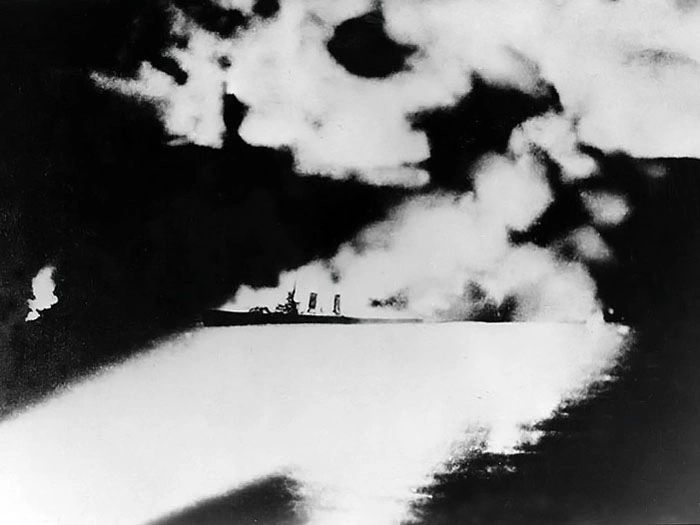
In another Japanese photograph, USS QUINCY CA-39 is illuminated by searchlights. Smoke pours skyward. The bow of ASTORIA, also under heavy fire at this time, appears to be visible at right. This is the final known photograph of QUINCY.
-Imperial Japanese Navy photo in Brent Jones collection
From the dispatch of CAPT Greenman:
ASTORIA was hit repeatedly throughout this period and fires were started on hangar, upper deck, well deck, boat deck, and in the wardroom country, crews living spaces above and below second deck forward, and above second deck aft.
Hits under foward main battery control, in bridge structure, and radio centers and in armored wiring column severed all ship control, fire control communications. Estimate ten salvos were fired by main battery, other batteries fired until crews were killed or driven out by fire on upper decks.
Hits in number one and two fire rooms severed fire main. Other hits ruptured three principal fire main risers cutting off water supply, making it impossible to adequately fight fires. Smoke and flame from topside fires entered fire room and engine room blowers and made it necessary for personnel to abandon these spaces. Almost coincidentally with loss of power on ship enemy ceased fire and disappeared.

A 1942 artist's depiction of the final moments of USS QUINCY.
-Alexander Leydenfrost drawing reprinted from LIFE magazine
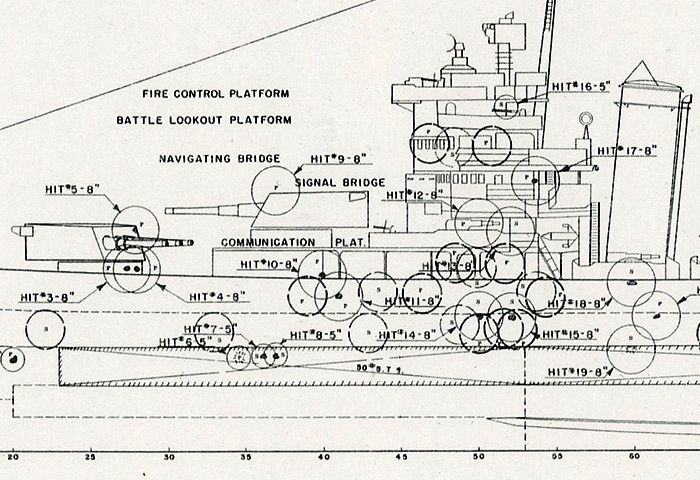
CLICK IMAGE TO OPEN FULL DIAGRAM
A portion of a U.S. Navy Bureau of Ships diagram showing the heavy concentration of enemy gunfire scoring hits around ASTORIA's bridge and forward superstructure. Her number one turret also suffered direct hits and was knocked out of action. This data was collected in the hours that ASTORIA remained afloat following the attack. For the complete diagram, click on the image.
-U.S. Navy document in Brent Jones collection
From the dispatch of CAPT Greenman:
One enemy vessel was definitely hit and possibly two. ASTORIA received at least seventeen large caliber hits and shrapnel. Turret one received one hit in face plate which made a clean hole measuring eleven inches in diameter. Two hits in barbette of same turret measured eight inches in diameter. All personnel in gun chamber, shell deck, and upper powder room of this turret were killed but no fires resulted.
After ship lost power and enemy withdrew, all personnel remaining were assembled on forecastle and main deck aft. Commenced fighting fires by bucket brigade and all other possible means. Fierce fires raging amidships prevented any communications between these groups and neither realized other group existed.
Extent of fire forward below second deck and uncertainty as to whether forward five-inch magazine group had been flooded made it advisable for forecastle group to leave the ship. BAGLEY [DD-386] was called alongside and all living personnel forward were transferred to that vessel at about 0445. BAGLEY stood by ASTORIA and rescued personnel in the water nearby.
At daybreak, discovered group on main deck aft. Topside fires amidships were subsiding somewhat and there appeared a possibility of salvaging the ship. Consequently, BAGLEY was requested to go alongside starboard quarter of ASTORIA to remove wounded and all personnel except those necessary for salvage.
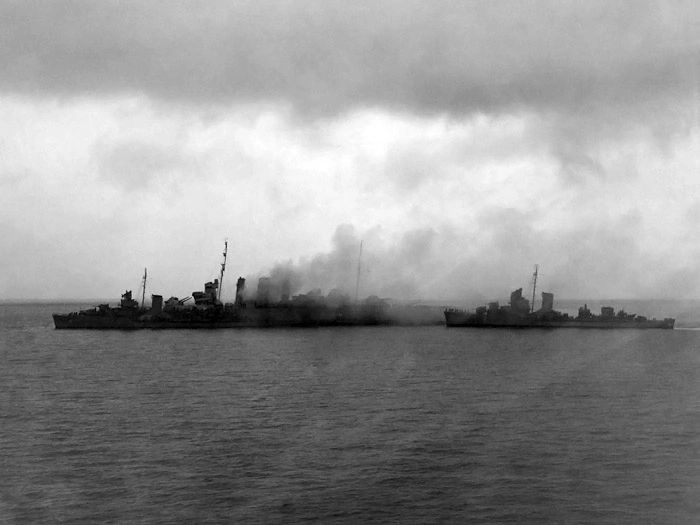
CLICK PHOTO TO ENLARGE
Above and below: South of Savo Island, American destroyers tend to HMAS CANBERRA in the morning hours of 9 August 1942. By the time these photographs were taken, VINCENNES and QUINCY were already in the depths of Iron Bottom Sound. CANBERRA sank shortly afterward, scuttled by torpedoes from USS ELLET DD-398 and SELFRIDGE DD-357. Although no photographs are known to exist of her final day, ASTORIA hung on tenaciously past noon before sinking.
-U.S. Navy photo in NARA record group 80-G-13488
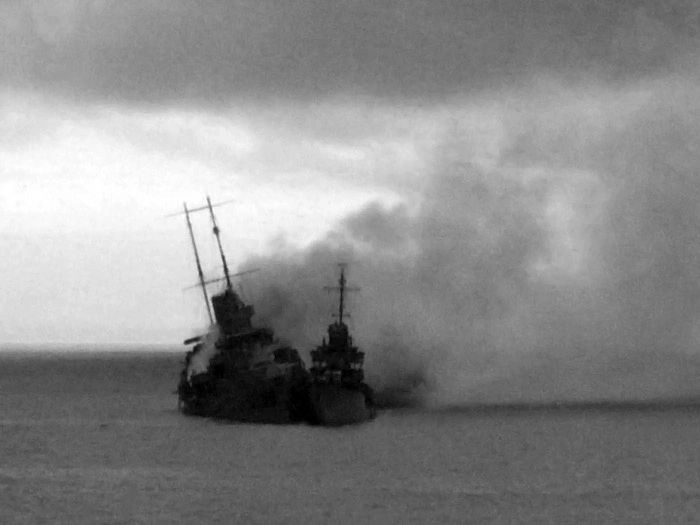
CLICK PHOTO TO ENLARGE
-U.S. Navy photo in NARA record group 80-G-13489
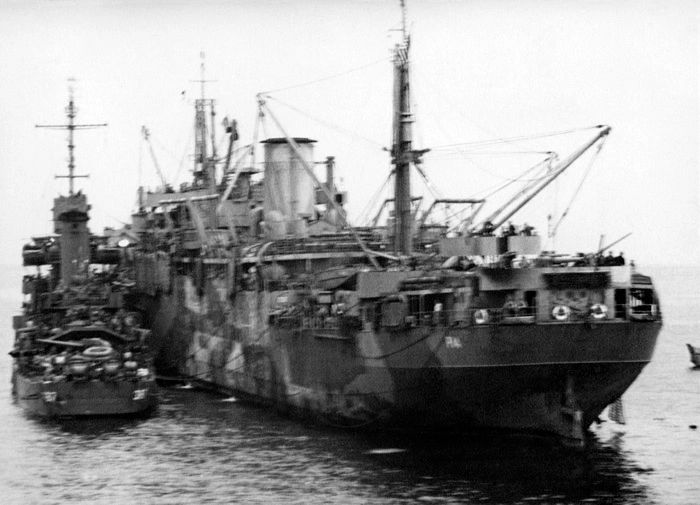
CLICK PHOTO TO ENLARGE
USS BLUE DD-387 alongside FULLER AP-14 transferring survivors from HMAS CANBERRA between 0747 and 0849 on 9 August 1942. Taken from HMAS HOBART.
-RAN photo from Brent Jones collection.
From the dispatch of CAPT Greenman:
Every effort was made by the salvage group during the next six hours to extinguish fires and get ship underway. It was found that after engine room and number four fire room were in such condition that this might be effected. About 0800 HOPKINS [DMS-13] took ship in tow, prepared to supply ship with power and headed for Yoke [Florida Island] Area.
Later WILSON [DD-408] came alongside to pump water in forward part of ship to assist in extinguishing fires. Shortly thereafter WILSON and HOPKINS were called away by the Task Force Commander.
At about 1130 forward five-inch magazine exploded blowing a hole in port side of ship below waterline. At about this time BUCHANAN [DD-484] attempted to come alongside to pump water but because ship had started to take a heavy list to port she was directed to take station close aboard starboard quarter to rescue personnel.
At about 1200 salvage group was directed to abandon ship, men sliding down lines and jumping into water. At 1215 ASTORIA capsized and sank.
BUCHANAN and ALCHIBA [AK-23] rescued all salvage crew. Out of a total of 83 officers, 990 enlisted men, and one civilian newspaper correspondent, Joe J. Custer, on board, incomplete information now at hand indicated 61 officers, the news correspondent and 629 men were rescued. Of this number 7 officers and 78 men are wounded, many seriously. 20 officers known dead, 2 unaccounted for. 138 enlisted men are known to be dead.
On board PRESIDENT JACKSON in addition to above are 6 officers and 43 men from VINCENNES and none from QUINCY. One LIFE Magazine photographer, Mr. Ralph Morse.
All secret and confidential publications were destroyed before any personnel left ASTORIA. Estimated period of the action was from 0155 to 0215.
W. G. Greenman, Captain U.S. Navy
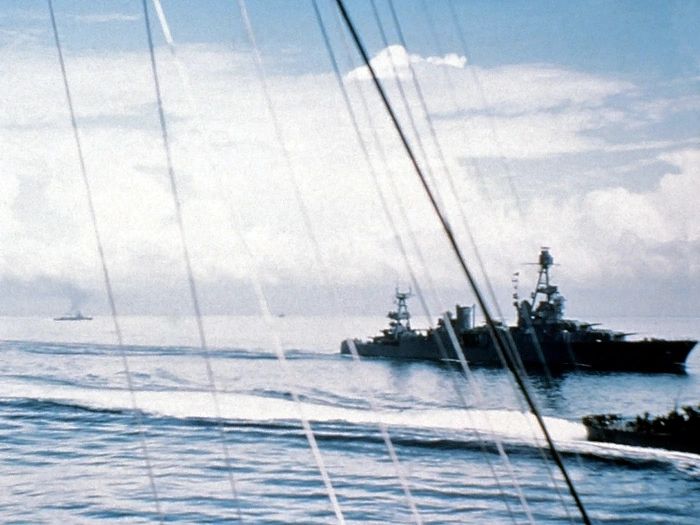
Without further air cover, and with surface forces severely compromised, Naval support for Operation WATCHTOWER is withdrawn on the afternoon of 9 August 1942. Supply unloading was not complete, and the decision to depart became a source of bitterness and contention amongst Marines in the months and years to come.
-U.S Navy photo in NARA collection 80-G-K-386
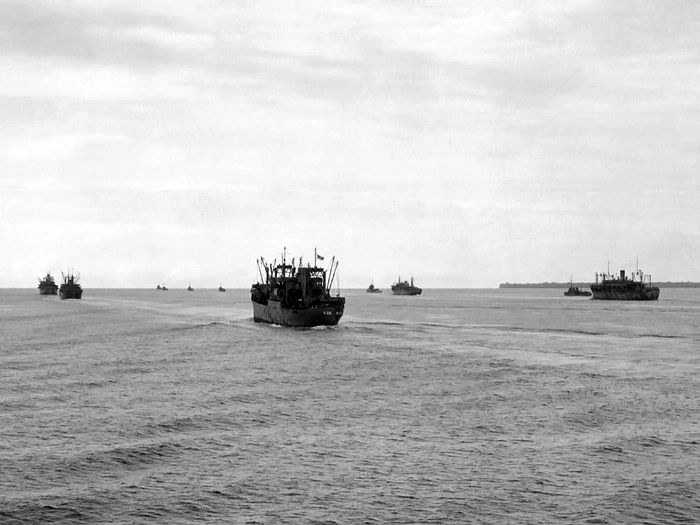
CLICK PHOTO TO ENLARGE
The transport force departs Savo Sound in the afternoon of 9 August 1942. In the foreground is USS BETELGEUSE AK-28.
-U.S. Navy photo in NARA record group 80-G-13496
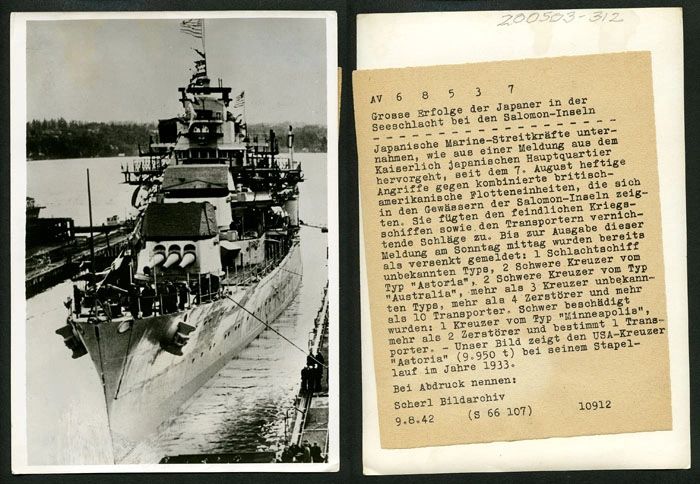
CLICK IMAGE TO ENLARGE
From the Japanese side, word of the Savo battle spread quickly. This German archive photo of ASTORIA ran the next day as part of a news story announcing "great Japanese victory in Solomon Islands sea battle." Imperial Japanese headquarters announced inflated claims of Allied losses, but there was truth at the core: While the story declared the sinking of two ASTORIA-class heavy cruisers and two AUSTRALIA-class, this was largely accurate--in reality three ASTORIA-class and one AUSTRALIA-class were sunk by the Imperial Japanese Navy.
-German press photo from Brent Jones collection
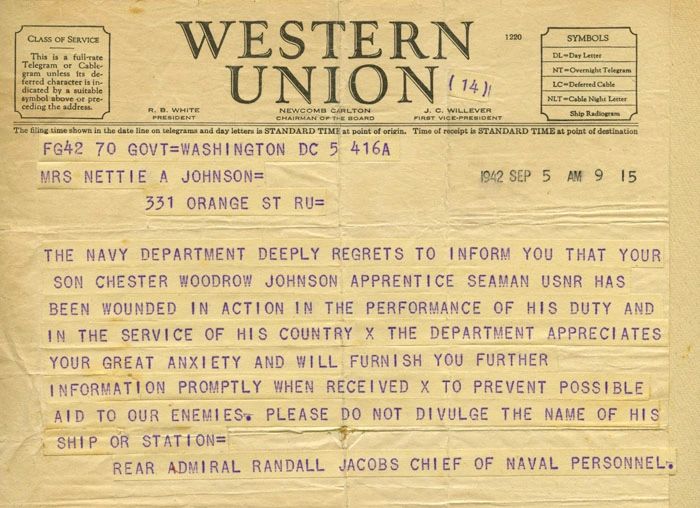
In sharp contrast to the press of the Axis Powers, Allied press reports of the battle, including the dispatches of Joe J. Custer, were suppressed. As survivors from the lost cruisers began the long journey back to the United States, weeks passed before families of the killed and wounded were notified. In this example, seriously wounded ASTORIA Sailor Chester Johnson's family did not receive notice until 5 September 1942--four weeks after the battle. By this time Johnson was in a Naval Hospital on Oahu.
-from Brent Jones collection
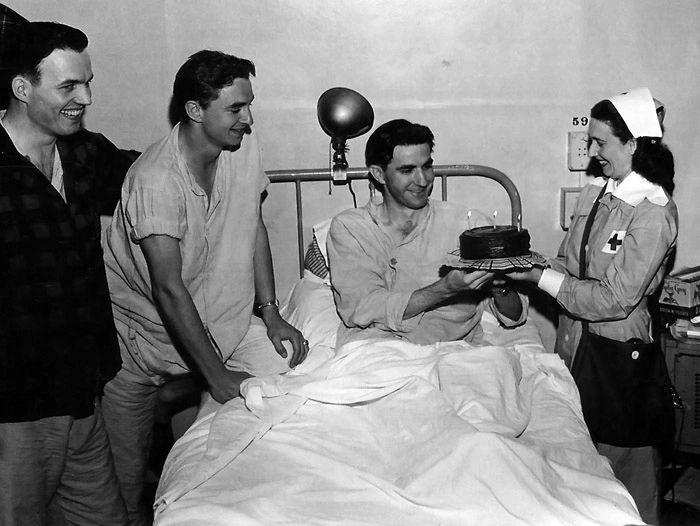
ASTORIA Sailor GM2/c Howard S. Taylor receives a cake while hospitalized from wounds received during the Battle of Savo Island in a photo circa September 1942.
-photo courtesy of Bryan Larson
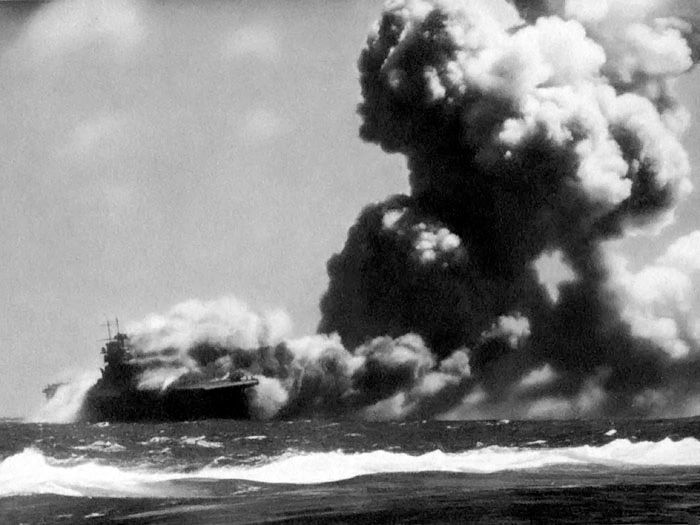
The Solomons Island battles raged on. On 15 September 1942, WASP CV-7 became the next American carrier sunk by Japan. The American public had still received no news reports of the Savo Island disaster back in August.
-U.S. Navy photo from Brent Jones collection
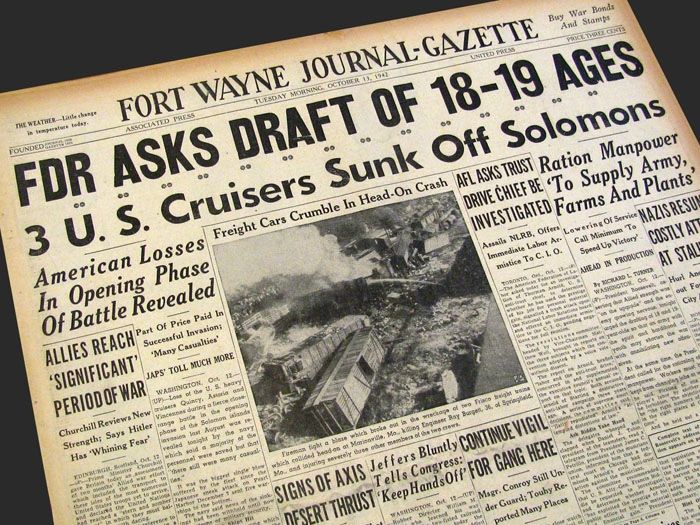
Finally on 13 October 1942, more than two months after the battle, the American public learned of the Savo disaster. By this time there were significant advances in the Guadalcanal campaign to announce that provided an offset for the shocking losses. On this date Joe Custer's dispatches were finally released.
-Fort Wayne Journal-Gazette from Brent Jones collection
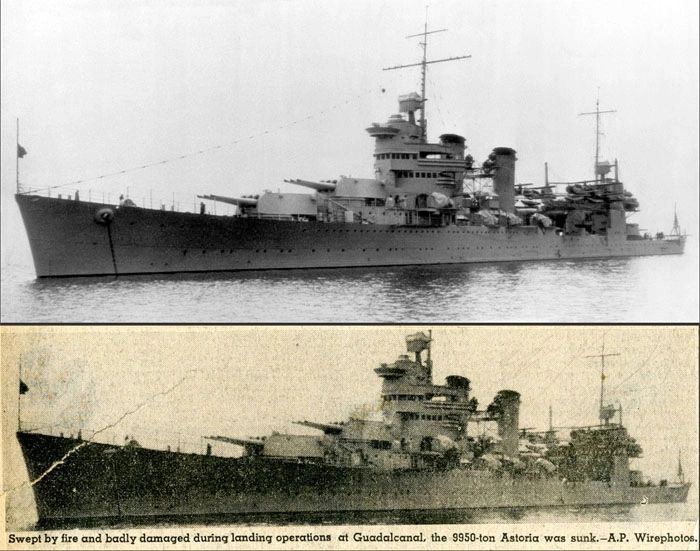
CLICK PHOTO TO ENLARGE
An AP wirephoto of USS ASTORIA used in many news accounts of her sinking. At top is the original wirephoto as sent, at bottom is an example of how it was utilized in final print copy. Note that a pre-war image is used; it was standard practice to utilize pre-war images so as not to divulge recent modifications, the most important of which was radar.
-AP Wirephoto from Brent Jones collection
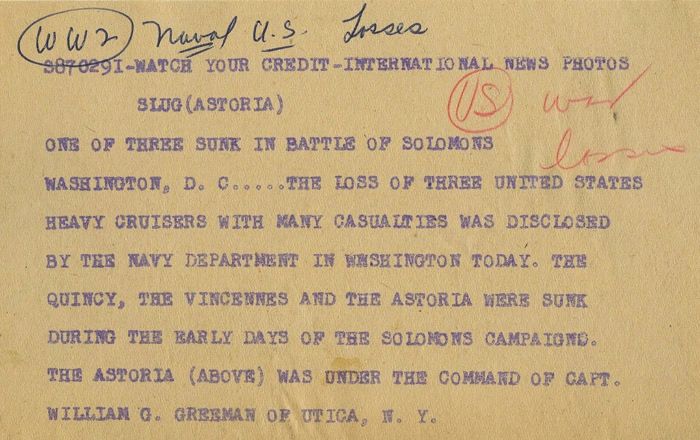
Caption and credit from an image of USS ASTORIA that ran in the Detroit Times on 13 October.
-International News photo reverse from Brent Jones collection
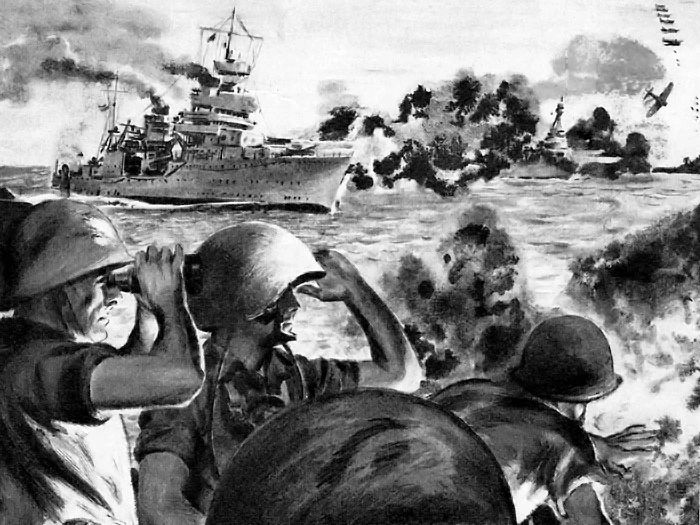
With the gag order lifted, accounts from USS ASTORIA survivors began to appear in newsprint and magazines. This three-image sequence of drawings was part of a larger spread covering the account of ASTORIA sailor Eddie Armes, which appeared in an unidentified magazine circa November 1942. From top, they depict ASTORIA in the Battle of Midway, the aerial attacks during the Invasion of Guadalcanal, and the Battle of Savo Island where Armes is throwing his own life vest to a man in the water.
-from Brent Jones collection
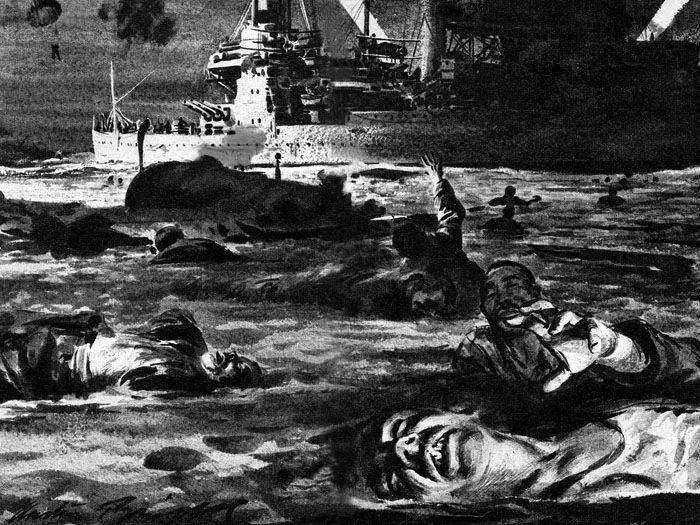
-from Brent Jones collection
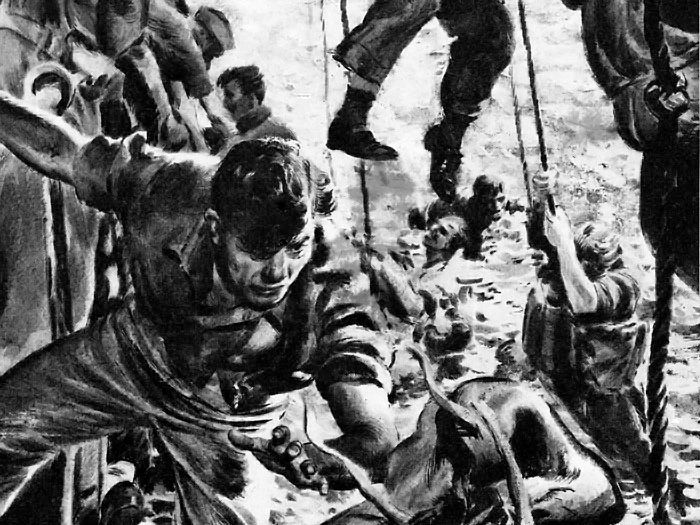
-from Brent Jones collection
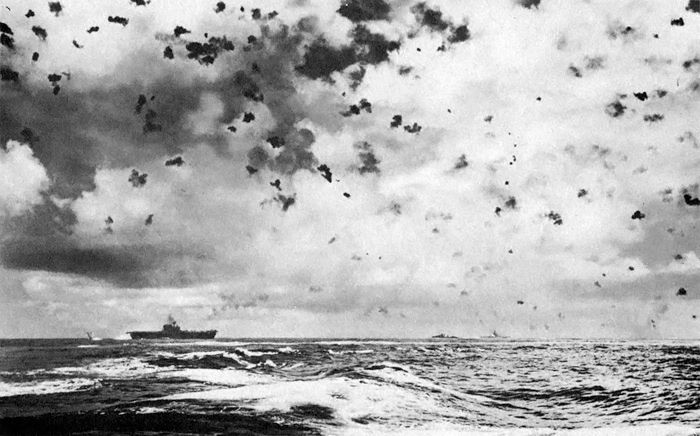
Following the Battle of Santa Cruz in October 1942, USS ENTERPRISE CV-6 was the only remaining American aircraft carrier in the Pacific Theater. Her crew defiantly placed a sign on deck that read "USS ENTERPRISE versus Japan."
-U.S. Navy photo from Brent Jones collection
While Midway may have been considered a turning point in the war, taking the battle to Japan was another matter. New construction aircraft carriers and cruisers began to slide down the ways bearing the names of ships lost at the Coral Sea, Midway, and Guadalcanal--"Vengeance ships," the Navy called them. In October 1942 it was decided that ASTORIA would be among them.

In late 1942, U.S. Navy publications announced that a new cruiser of the U.S. Navy should bear the namesake of ASTORIA CA-34. While the heavy cruiser was named for the city of Astoria, Oregon, this new ship would be named specifically in honor of "Nasty Asty."
The above image was widely circulated in articles regarding the loss of ASTORIA, but the ship in the photograph is actually USS NEW ORLEANS CA-32. Several significant details vary from ASTORIA: Blast bags are present and the signal bridge has not been plated.
-U.S. Navy publication and postcard from Brent Jones collection
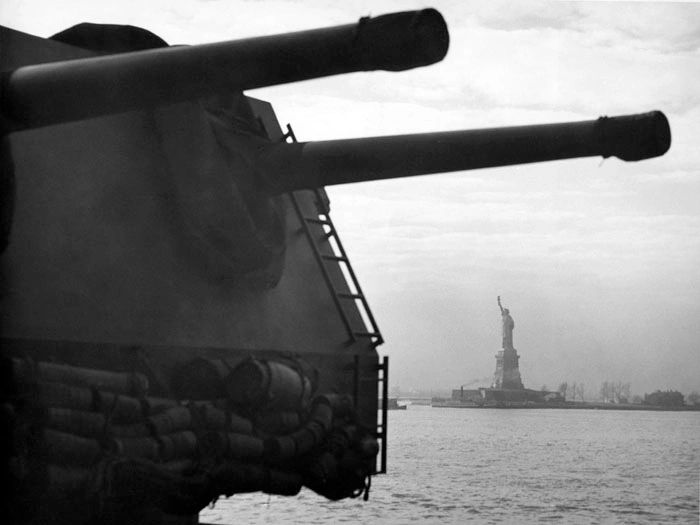
CLICK PHOTO TO ENLARGE
Four U.S. Navy cruisers were ultimately renamed in honor of the Savo losses: VINCENNES CL-64, CANBERRA CA-70, QUINCY CA-71 and ASTORIA CL-90. In this image USS QUINCY sails past the Statue of Liberty in New York Harbor circa 1943.
-U.S. Navy photo from Brent Jones collection

At Cramp Shipbuilding Company in Philadelphia, workers assemble the keel and lower partitions of Hull No. 533. While Hull 533 was laid down as USS WILKES-BARRE CL-90, fate intervened and the ship's name was changed to ASTORIA.
-U.S. Navy photo from NARA collection 19-LCM

CLICK PHOTO TO ENLARGE
On 6 March 1943, the newly-renamed USS ASTORIA CL-90 was launched into the Delaware River at Cramp Shipbuilding Company.
-U.S. Navy photo from NARA collection 80-G-038144
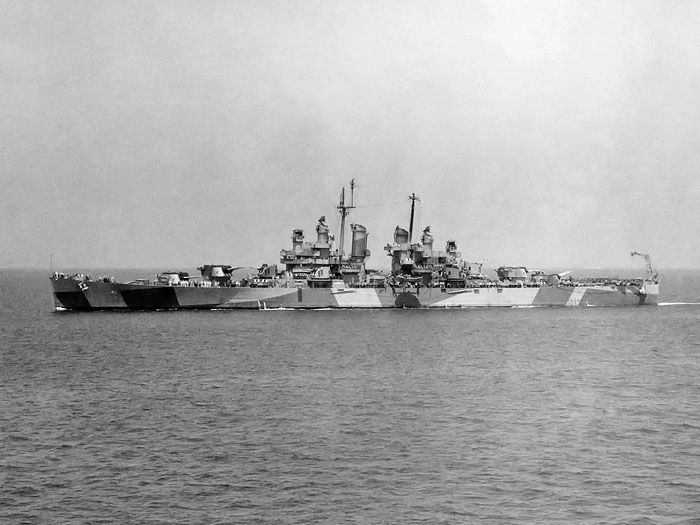
CLICK PHOTO TO ENLARGE
On 18 June 1944, light cruiser USS ASTORIA CL-90 was photographed off Norfolk by USS TRIPOLI while underway in final preparations for her shakedown cruise.
-U.S. Navy photo from NARA collection 80-G-364894
The war experience of ASTORIA CL-90 began in 1944, and she served in the Pacific until the end of the war. She saw significant action and brought honor to the memory of her namesake. The history of this light cruiser, the "Mighty Ninety," is also told through first-hand accounts, documents and photographs at another of my websites: www.mighty90.com.
Sources
Custer, Joe James. Through the Perilous Night: The Astoria's Last Battle. New York, NY: The MacMillan Company, 1944.
Jones, Brent. Private photo and document collection.
National Archives and Records Administration. http://www.archives.gov/research/.
NavSource Navy Historical Photograph Database. http://www.navsource.org/
USS ASTORIA CA-34 Blue Book. Privately printed, 1972.
Wiemer, Robert S. Private photo and document collection.
Return to In Memoriam

Continue to Ship's Crew

BACK TO USS ASTORIA HOMEPAGE
The Battle of Savo Island: 9 August 1942

CLICK IMAGE TO ENLARGE
An iconic painting of the Battle of Savo Island. IJN YUBARI opens fire on the American cruisers ASTORIA, QUINCY and VINCENNES, each of which are bathed in Japanese searchlights.
-John Hamilton painting in the U.S. Navy Art Collection
Note: The following account is not intended to be a definitive account of the 1st Battle of Savo Island. This is primarily due to space and time constraints, as there are many accounts of this battle readily available online and in print. In the future I plan to expand upon what is documented here; for now the primary focus surrounds USS ASTORIA. The after-action reports of ASTORIA's CAPT Greenman are used to provide the progression of the battle.
At 1000 local time on 11 August 1942, the Commanding Officer of USS ASTORIA, CAPT. William G. Greenman, lay wounded aboard transport USS PRESIDENT JACKSON. Less than forty-eight hours had passed since his ship had succumbed to wounds and slipped beneath the surface in Savo Sound.
Greenman sent the following dispatch:
110200 (Mailgram) URGENT
Following preliminary report from Captain Greenman USN on cruiser action early morning of 9 August off Florida Island.
VINCENNES, QUINCY and ASTORIA while on patrol in channel eastward of Savo Island about 0155 LOVE [local time] August 9th were attacked by an enemy force of unknown number presumably four CA [heavy cruisers] and unknown number of DD [destroyers].
At time of attack our cruisers were in column; order of ships: VINCENNES, QUINCY and ASTORIA, on course 315, speed 10 with two DDs as A/S [anti-submarine] screen. First indication of enemy action was indicated by four aircraft flares seen about 5000 yards bearing 135 to 155 true from this vessel.
Enemy apparently came in under the shadow of Savo Island and made their initial attack from our port quarter bearing about 190-195 true and on easterly courses concentrating on ships from the van. Shortly after flares were dropped and seen searchlights to right of flares appeared and the enemy opened fire.

A 1942 artist's depiction of the opening moments of the Battle of Savo Island. At lower left, American transports continue to unload supplies at Guadalcanal. At center right is Savo Island, where Imperial Japanese Navy ships enter the Sound. A Japanese floatplane begins to drop flares overhead.
-Alexander Leydenfrost drawing reprinted from LIFE magazine

In a photograph taken from IJN CHOKAI, flares drop over the southern cruiser group of USS CHICAGO CA-29 and HMAS CANBERRA.
-Imperial Japanese Navy photo in Brent Jones collection

CLICK IMAGE TO ENLARGE
A 1944 drawing of the progression of the battle correctly depicts the path of the attacking Japanese force past the southern cruiser group. However, it does not reflect that the Japanese conducted the attack on the northern group from two angles, effectively placing VINCENNES, QUINCY and ASTORIA in a crossfire.
From the dispatch of CAPT Greenman:
Fire was returned to port immediately by ASTORIA, VINCENNES and QUINCY in that order. ASTORIA FC [fire control] radar range gave 5640 yards. Preliminary conclusions are that the enemy ships were in two separate sections for shortly after fire was observed to port ships also received fire from starboard quarter which placed column under a cross fire.

CLICK IMAGE TO ENLARGE
An artist's depiction of the northern group taking intense fire from Japanese ships.
-John Hamilton painting in the U.S. Navy Art Collection
From the dispatch of CAPT Greenman:
VINCENNES observed to be hit immediately and shortly afterward an explosion was observed and vessel disappeared. Survivors report that vessel turned over to port. A few minutes later QUINCY was hit and set afire from bow to stern and was out of control and within fifteen [minutes] blew up and sank.

In another Japanese photograph, USS QUINCY CA-39 is illuminated by searchlights. Smoke pours skyward. The bow of ASTORIA, also under heavy fire at this time, appears to be visible at right. This is the final known photograph of QUINCY.
-Imperial Japanese Navy photo in Brent Jones collection
From the dispatch of CAPT Greenman:
ASTORIA was hit repeatedly throughout this period and fires were started on hangar, upper deck, well deck, boat deck, and in the wardroom country, crews living spaces above and below second deck forward, and above second deck aft.
Hits under foward main battery control, in bridge structure, and radio centers and in armored wiring column severed all ship control, fire control communications. Estimate ten salvos were fired by main battery, other batteries fired until crews were killed or driven out by fire on upper decks.
Hits in number one and two fire rooms severed fire main. Other hits ruptured three principal fire main risers cutting off water supply, making it impossible to adequately fight fires. Smoke and flame from topside fires entered fire room and engine room blowers and made it necessary for personnel to abandon these spaces. Almost coincidentally with loss of power on ship enemy ceased fire and disappeared.

A 1942 artist's depiction of the final moments of USS QUINCY.
-Alexander Leydenfrost drawing reprinted from LIFE magazine

CLICK IMAGE TO OPEN FULL DIAGRAM
A portion of a U.S. Navy Bureau of Ships diagram showing the heavy concentration of enemy gunfire scoring hits around ASTORIA's bridge and forward superstructure. Her number one turret also suffered direct hits and was knocked out of action. This data was collected in the hours that ASTORIA remained afloat following the attack. For the complete diagram, click on the image.
-U.S. Navy document in Brent Jones collection
From the dispatch of CAPT Greenman:
One enemy vessel was definitely hit and possibly two. ASTORIA received at least seventeen large caliber hits and shrapnel. Turret one received one hit in face plate which made a clean hole measuring eleven inches in diameter. Two hits in barbette of same turret measured eight inches in diameter. All personnel in gun chamber, shell deck, and upper powder room of this turret were killed but no fires resulted.
After ship lost power and enemy withdrew, all personnel remaining were assembled on forecastle and main deck aft. Commenced fighting fires by bucket brigade and all other possible means. Fierce fires raging amidships prevented any communications between these groups and neither realized other group existed.
Extent of fire forward below second deck and uncertainty as to whether forward five-inch magazine group had been flooded made it advisable for forecastle group to leave the ship. BAGLEY [DD-386] was called alongside and all living personnel forward were transferred to that vessel at about 0445. BAGLEY stood by ASTORIA and rescued personnel in the water nearby.
At daybreak, discovered group on main deck aft. Topside fires amidships were subsiding somewhat and there appeared a possibility of salvaging the ship. Consequently, BAGLEY was requested to go alongside starboard quarter of ASTORIA to remove wounded and all personnel except those necessary for salvage.

CLICK PHOTO TO ENLARGE
Above and below: South of Savo Island, American destroyers tend to HMAS CANBERRA in the morning hours of 9 August 1942. By the time these photographs were taken, VINCENNES and QUINCY were already in the depths of Iron Bottom Sound. CANBERRA sank shortly afterward, scuttled by torpedoes from USS ELLET DD-398 and SELFRIDGE DD-357. Although no photographs are known to exist of her final day, ASTORIA hung on tenaciously past noon before sinking.
-U.S. Navy photo in NARA record group 80-G-13488

CLICK PHOTO TO ENLARGE
-U.S. Navy photo in NARA record group 80-G-13489

CLICK PHOTO TO ENLARGE
USS BLUE DD-387 alongside FULLER AP-14 transferring survivors from HMAS CANBERRA between 0747 and 0849 on 9 August 1942. Taken from HMAS HOBART.
-RAN photo from Brent Jones collection.
From the dispatch of CAPT Greenman:
Every effort was made by the salvage group during the next six hours to extinguish fires and get ship underway. It was found that after engine room and number four fire room were in such condition that this might be effected. About 0800 HOPKINS [DMS-13] took ship in tow, prepared to supply ship with power and headed for Yoke [Florida Island] Area.
Later WILSON [DD-408] came alongside to pump water in forward part of ship to assist in extinguishing fires. Shortly thereafter WILSON and HOPKINS were called away by the Task Force Commander.
At about 1130 forward five-inch magazine exploded blowing a hole in port side of ship below waterline. At about this time BUCHANAN [DD-484] attempted to come alongside to pump water but because ship had started to take a heavy list to port she was directed to take station close aboard starboard quarter to rescue personnel.
At about 1200 salvage group was directed to abandon ship, men sliding down lines and jumping into water. At 1215 ASTORIA capsized and sank.
BUCHANAN and ALCHIBA [AK-23] rescued all salvage crew. Out of a total of 83 officers, 990 enlisted men, and one civilian newspaper correspondent, Joe J. Custer, on board, incomplete information now at hand indicated 61 officers, the news correspondent and 629 men were rescued. Of this number 7 officers and 78 men are wounded, many seriously. 20 officers known dead, 2 unaccounted for. 138 enlisted men are known to be dead.
On board PRESIDENT JACKSON in addition to above are 6 officers and 43 men from VINCENNES and none from QUINCY. One LIFE Magazine photographer, Mr. Ralph Morse.
All secret and confidential publications were destroyed before any personnel left ASTORIA. Estimated period of the action was from 0155 to 0215.
W. G. Greenman, Captain U.S. Navy

Without further air cover, and with surface forces severely compromised, Naval support for Operation WATCHTOWER is withdrawn on the afternoon of 9 August 1942. Supply unloading was not complete, and the decision to depart became a source of bitterness and contention amongst Marines in the months and years to come.
-U.S Navy photo in NARA collection 80-G-K-386

CLICK PHOTO TO ENLARGE
The transport force departs Savo Sound in the afternoon of 9 August 1942. In the foreground is USS BETELGEUSE AK-28.
-U.S. Navy photo in NARA record group 80-G-13496

CLICK IMAGE TO ENLARGE
From the Japanese side, word of the Savo battle spread quickly. This German archive photo of ASTORIA ran the next day as part of a news story announcing "great Japanese victory in Solomon Islands sea battle." Imperial Japanese headquarters announced inflated claims of Allied losses, but there was truth at the core: While the story declared the sinking of two ASTORIA-class heavy cruisers and two AUSTRALIA-class, this was largely accurate--in reality three ASTORIA-class and one AUSTRALIA-class were sunk by the Imperial Japanese Navy.
-German press photo from Brent Jones collection

In sharp contrast to the press of the Axis Powers, Allied press reports of the battle, including the dispatches of Joe J. Custer, were suppressed. As survivors from the lost cruisers began the long journey back to the United States, weeks passed before families of the killed and wounded were notified. In this example, seriously wounded ASTORIA Sailor Chester Johnson's family did not receive notice until 5 September 1942--four weeks after the battle. By this time Johnson was in a Naval Hospital on Oahu.
-from Brent Jones collection

ASTORIA Sailor GM2/c Howard S. Taylor receives a cake while hospitalized from wounds received during the Battle of Savo Island in a photo circa September 1942.
-photo courtesy of Bryan Larson

The Solomons Island battles raged on. On 15 September 1942, WASP CV-7 became the next American carrier sunk by Japan. The American public had still received no news reports of the Savo Island disaster back in August.
-U.S. Navy photo from Brent Jones collection

Finally on 13 October 1942, more than two months after the battle, the American public learned of the Savo disaster. By this time there were significant advances in the Guadalcanal campaign to announce that provided an offset for the shocking losses. On this date Joe Custer's dispatches were finally released.
-Fort Wayne Journal-Gazette from Brent Jones collection

CLICK PHOTO TO ENLARGE
An AP wirephoto of USS ASTORIA used in many news accounts of her sinking. At top is the original wirephoto as sent, at bottom is an example of how it was utilized in final print copy. Note that a pre-war image is used; it was standard practice to utilize pre-war images so as not to divulge recent modifications, the most important of which was radar.
-AP Wirephoto from Brent Jones collection

Caption and credit from an image of USS ASTORIA that ran in the Detroit Times on 13 October.
-International News photo reverse from Brent Jones collection

With the gag order lifted, accounts from USS ASTORIA survivors began to appear in newsprint and magazines. This three-image sequence of drawings was part of a larger spread covering the account of ASTORIA sailor Eddie Armes, which appeared in an unidentified magazine circa November 1942. From top, they depict ASTORIA in the Battle of Midway, the aerial attacks during the Invasion of Guadalcanal, and the Battle of Savo Island where Armes is throwing his own life vest to a man in the water.
-from Brent Jones collection

-from Brent Jones collection

-from Brent Jones collection

Following the Battle of Santa Cruz in October 1942, USS ENTERPRISE CV-6 was the only remaining American aircraft carrier in the Pacific Theater. Her crew defiantly placed a sign on deck that read "USS ENTERPRISE versus Japan."
-U.S. Navy photo from Brent Jones collection
While Midway may have been considered a turning point in the war, taking the battle to Japan was another matter. New construction aircraft carriers and cruisers began to slide down the ways bearing the names of ships lost at the Coral Sea, Midway, and Guadalcanal--"Vengeance ships," the Navy called them. In October 1942 it was decided that ASTORIA would be among them.

In late 1942, U.S. Navy publications announced that a new cruiser of the U.S. Navy should bear the namesake of ASTORIA CA-34. While the heavy cruiser was named for the city of Astoria, Oregon, this new ship would be named specifically in honor of "Nasty Asty."
The above image was widely circulated in articles regarding the loss of ASTORIA, but the ship in the photograph is actually USS NEW ORLEANS CA-32. Several significant details vary from ASTORIA: Blast bags are present and the signal bridge has not been plated.
-U.S. Navy publication and postcard from Brent Jones collection

CLICK PHOTO TO ENLARGE
Four U.S. Navy cruisers were ultimately renamed in honor of the Savo losses: VINCENNES CL-64, CANBERRA CA-70, QUINCY CA-71 and ASTORIA CL-90. In this image USS QUINCY sails past the Statue of Liberty in New York Harbor circa 1943.
-U.S. Navy photo from Brent Jones collection

At Cramp Shipbuilding Company in Philadelphia, workers assemble the keel and lower partitions of Hull No. 533. While Hull 533 was laid down as USS WILKES-BARRE CL-90, fate intervened and the ship's name was changed to ASTORIA.
-U.S. Navy photo from NARA collection 19-LCM

CLICK PHOTO TO ENLARGE
On 6 March 1943, the newly-renamed USS ASTORIA CL-90 was launched into the Delaware River at Cramp Shipbuilding Company.
-U.S. Navy photo from NARA collection 80-G-038144

CLICK PHOTO TO ENLARGE
On 18 June 1944, light cruiser USS ASTORIA CL-90 was photographed off Norfolk by USS TRIPOLI while underway in final preparations for her shakedown cruise.
-U.S. Navy photo from NARA collection 80-G-364894
The war experience of ASTORIA CL-90 began in 1944, and she served in the Pacific until the end of the war. She saw significant action and brought honor to the memory of her namesake. The history of this light cruiser, the "Mighty Ninety," is also told through first-hand accounts, documents and photographs at another of my websites: www.mighty90.com.
Sources
Custer, Joe James. Through the Perilous Night: The Astoria's Last Battle. New York, NY: The MacMillan Company, 1944.
Jones, Brent. Private photo and document collection.
National Archives and Records Administration. http://www.archives.gov/research/.
NavSource Navy Historical Photograph Database. http://www.navsource.org/
USS ASTORIA CA-34 Blue Book. Privately printed, 1972.
Wiemer, Robert S. Private photo and document collection.
Return to In Memoriam

Continue to Ship's Crew

BACK TO USS ASTORIA HOMEPAGE
